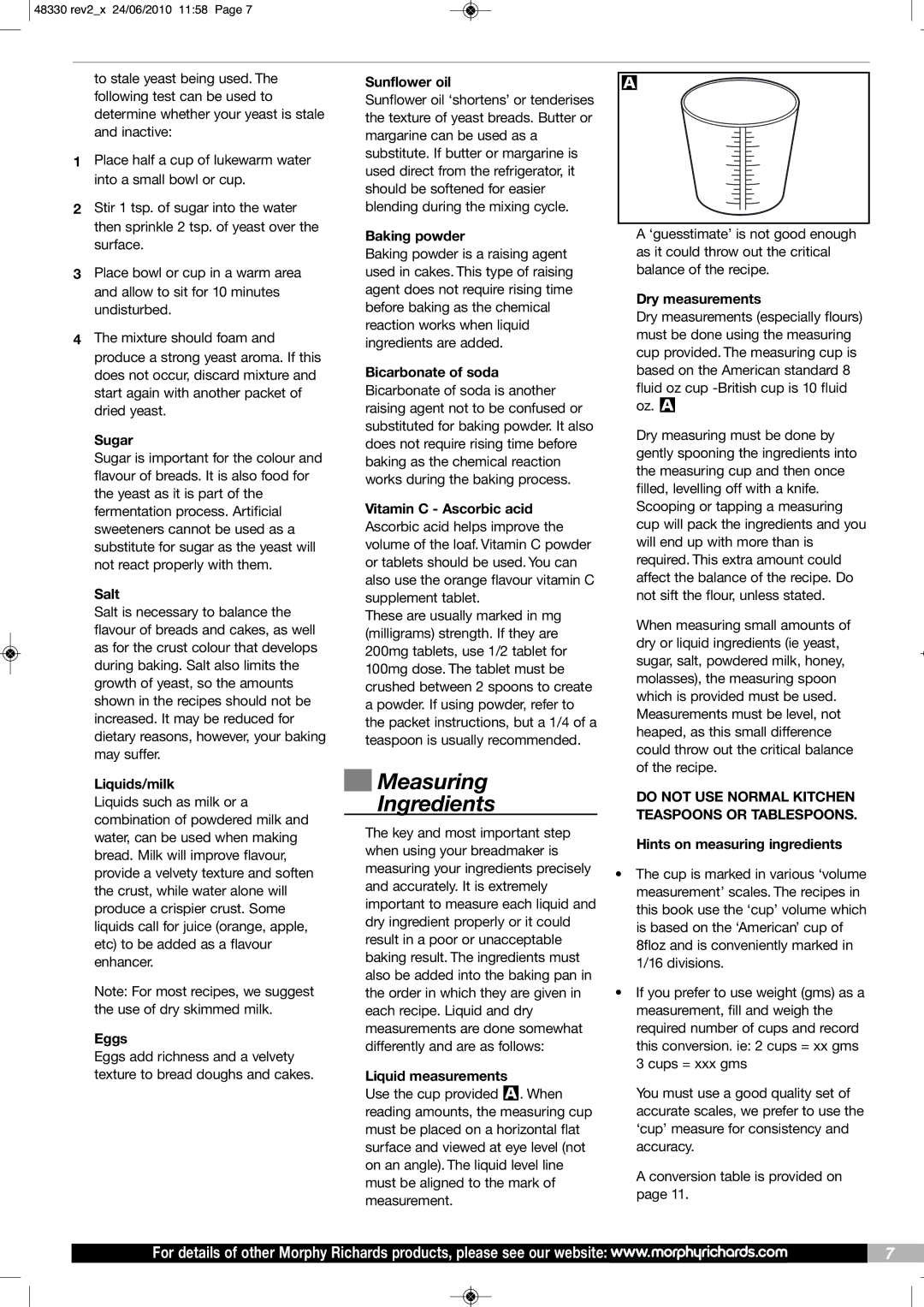to stale yeast being used. The following test can be used to determine whether your yeast is stale and inactive:
1Place half a cup of lukewarm water into a small bowl or cup.
2Stir 1 tsp. of sugar into the water then sprinkle 2 tsp. of yeast over the surface.
3Place bowl or cup in a warm area and allow to sit for 10 minutes undisturbed.
4The mixture should foam and produce a strong yeast aroma. If this does not occur, discard mixture and start again with another packet of dried yeast.
Sugar
Sugar is important for the colour and flavour of breads. It is also food for the yeast as it is part of the fermentation process. Artificial sweeteners cannot be used as a substitute for sugar as the yeast will not react properly with them.
Salt
Salt is necessary to balance the flavour of breads and cakes, as well as for the crust colour that develops during baking. Salt also limits the growth of yeast, so the amounts shown in the recipes should not be increased. It may be reduced for dietary reasons, however, your baking may suffer.
Liquids/milk
Liquids such as milk or a combination of powdered milk and water, can be used when making bread. Milk will improve flavour, provide a velvety texture and soften the crust, while water alone will produce a crispier crust. Some liquids call for juice (orange, apple, etc) to be added as a flavour enhancer.
Note: For most recipes, we suggest the use of dry skimmed milk.
Eggs
Eggs add richness and a velvety texture to bread doughs and cakes.
Sunflower oil
Sunflower oil ‘shortens’ or tenderises the texture of yeast breads. Butter or margarine can be used as a substitute. If butter or margarine is used direct from the refrigerator, it should be softened for easier blending during the mixing cycle.
Baking powder
Baking powder is a raising agent used in cakes. This type of raising agent does not require rising time before baking as the chemical reaction works when liquid ingredients are added.
Bicarbonate of soda
Bicarbonate of soda is another raising agent not to be confused or substituted for baking powder. It also does not require rising time before baking as the chemical reaction works during the baking process.
Vitamin C - Ascorbic acid
Ascorbic acid helps improve the volume of the loaf. Vitamin C powder or tablets should be used. You can also use the orange flavour vitamin C supplement tablet.
These are usually marked in mg (milligrams) strength. If they are 200mg tablets, use 1/2 tablet for 100mg dose. The tablet must be crushed between 2 spoons to create a powder. If using powder, refer to the packet instructions, but a 1/4 of a teaspoon is usually recommended.
Measuring
Ingredients
The key and most important step when using your breadmaker is measuring your ingredients precisely and accurately. It is extremely important to measure each liquid and dry ingredient properly or it could result in a poor or unacceptable baking result. The ingredients must also be added into the baking pan in the order in which they are given in each recipe. Liquid and dry measurements are done somewhat differently and are as follows:
Liquid measurements
Use the cup provided A. When reading amounts, the measuring cup must be placed on a horizontal flat surface and viewed at eye level (not on an angle). The liquid level line must be aligned to the mark of measurement.
A
A ‘guesstimate’ is not good enough as it could throw out the critical balance of the recipe.
Dry measurements
Dry measurements (especially flours) must be done using the measuring cup provided. The measuring cup is based on the American standard 8 fluid oz cup -British cup is 10 fluid oz. A
Dry measuring must be done by gently spooning the ingredients into the measuring cup and then once filled, levelling off with a knife. Scooping or tapping a measuring cup will pack the ingredients and you will end up with more than is required. This extra amount could affect the balance of the recipe. Do not sift the flour, unless stated.
When measuring small amounts of dry or liquid ingredients (ie yeast, sugar, salt, powdered milk, honey, molasses), the measuring spoon which is provided must be used. Measurements must be level, not heaped, as this small difference could throw out the critical balance of the recipe.
DO NOT USE NORMAL KITCHEN TEASPOONS OR TABLESPOONS.
Hints on measuring ingredients
•The cup is marked in various ‘volume measurement’ scales. The recipes in this book use the ‘cup’ volume which is based on the ‘American’ cup of 8floz and is conveniently marked in 1/16 divisions.
•If you prefer to use weight (gms) as a measurement, fill and weigh the required number of cups and record this conversion. ie: 2 cups = xx gms 3 cups = xxx gms
You must use a good quality set of accurate scales, we prefer to use the ‘cup’ measure for consistency and accuracy.
A conversion table is provided on page 11.

